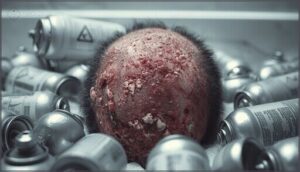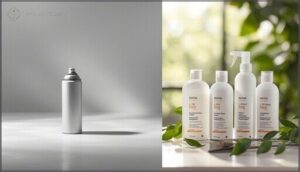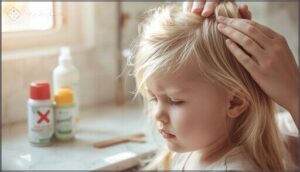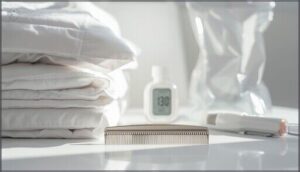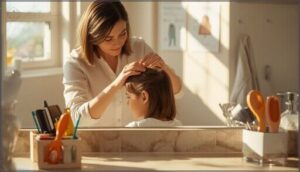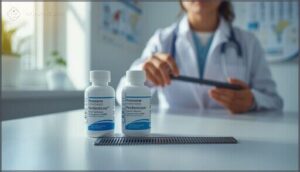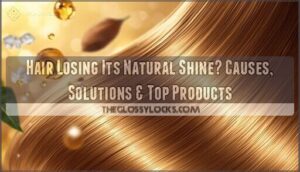This site is supported by our readers. We may earn a commission, at no cost to you, if you purchase through links.
When your child comes home with lice, panic sets in—and so does the desperate scramble for quick fixes. You’ve probably heard someone swear that hairspray works wonders, claiming it suffocates lice or glues them in place.
The truth? Hairspray doesn’t kill lice or their eggs, and there’s zero scientific evidence to back up this home remedy. What it does do is create a sticky mess on your child’s scalp, making it harder to spot nits and potentially exposing them to harsh chemicals like alcohol and formaldehyde.
Instead of wasting time with ineffective solutions, you need proven treatments that actually work—from FDA-approved shampoos to proper combing techniques that break the infestation cycle for good.
Table Of Contents
Key Takeaways
- Hairspray doesn’t kill lice or their eggs despite popular myths—no peer-reviewed studies support its effectiveness, and health authorities like the CDC don’t recommend it as a treatment.
- Using hairspray on your child’s scalp creates real risks including chemical exposure to alcohol and formaldehyde, scalp irritation affecting up to 30% of children, respiratory issues, and flammability hazards.
- Proven lice treatments include FDA-approved shampoos with permethrin (70-85% effective), prescription medications like spinosad for resistant cases (85% effective), and metal fine-toothed nit combs that physically remove lice and eggs.
- Effective prevention requires weekly scalp checks (cuts outbreak duration by 30%), teaching kids to avoid head-to-head contact (responsible for 80% of cases), and washing bedding in hot water at least 130°F to eliminate eggs.
Does Hairspray Kill Lice?
You’ve probably heard someone suggest using hairspray to kill lice, maybe from a friend or online forum. But before you reach for that aerosol can, it’s important to understand what the science actually says.
Let’s look at the evidence, how hairspray really interacts with lice, and which common beliefs don’t hold up under scrutiny.
Scientific Evidence on Hairspray Effectiveness
Despite what you may have heard, hairspray doesn’t kill lice. No peer-reviewed studies support the effectiveness of hairspray for lice treatment, and health authorities like the CDC don’t recommend it.
Hairspray doesn’t kill lice—no peer-reviewed studies support its use, and the CDC doesn’t recommend it
Lab studies show specialized sprays work through occlusion, but standard cosmetic hairspray lacks those properties. Due to resistance to common treatments, the efficacy of some products has greatly decreased.
Resistance factors have shifted focus to proven lice treatment methods, leaving spray limitations clear.
How Hairspray Interacts With Lice
You might wonder if hairspray creates some kind of physical barrier against lice. When you spray it on your hair, the sticky residue can temporarily slow lice down, reducing their mobility along hair shafts. This doesn’t disrupt their feeding, though.
Lice develop tolerance levels to cosmetic products quickly, and once you wash your hair, any minimal residue effects disappear, leaving the effectiveness of hairspray practically zero for actual lice treatment. In fact, there’s no scientific evidence that hairspray kills lice.
Common Myths About Hairspray and Lice
The lack of hairspray efficacy against lice hasn’t stopped several persistent myths from circulating. One common misconception claims that hairspray prevents lice infestations by making hair too slippery for lice to grab. Another suggests a hygiene connection, that lice prefer clean hair so hairspray somehow deters them.
These home remedy beliefs persist despite zero scientific support for hairspray as a legitimate lice treatment or prevention.
Can Hairspray Kill Lice Eggs (Nits)?
Even if hairspray could slow down adult lice, the eggs present a completely different challenge. Nits have a protective shell that’s designed to keep the developing louse safe until it hatches, which makes them remarkably hard to eliminate.
Let’s look at why hairspray won’t work against these stubborn eggs and what actually happens when you try.
Lice Egg Structure and Protection
Lice eggs, or nits, aren’t just tiny specks stuck to hair—they’re biological fortresses designed to protect developing lice. Understanding their structure helps explain why removal can be so challenging:
- Nit sheath proteins form cross-linked barriers that resist chemicals and environmental stress
- Mechanical shell strength from sclerotized proteins makes the egg physically tough to crush
- Aeropyle gas exchange pores allow breathing while blocking toxin entry
- Attachment glue bonds nits firmly to hair, resisting dislodgement during the lice life cycle
Research on Hairspray’s Effect on Nits
When you search for credible studies on hairspray killing nits, you won’t find any. Peer-reviewed research shows that conventional hairspray lacks ovicidal properties—it simply can’t penetrate the chitin protection surrounding lice eggs.
Dimethicone-based products demonstrate some efficacy, but standard hairspray formulations fail laboratory testing.
Clinical evidence overwhelmingly confirms physical removal with proper combing techniques as the only reliable method for eliminating nits.
Challenges in Removing Nits With Hairspray
Hairspray creates a sticky film that makes nit detection harder, not easier. The hardened texture increases comb snagging and requires multiple passes over the same hair sections.
You’ll face adhesion difficulties since hairspray doesn’t weaken the water-insoluble glue anchoring nits to hair shafts. Chemical inactivity means it lacks the ovicidal agents needed for effective lice and nits removal, ultimately delaying proper treatment.
Risks of Using Hairspray for Lice Treatment
Using hairspray to treat lice isn’t just ineffective—it can actually create new problems for you and your child. The chemicals in hairspray weren’t designed for your scalp, and applying them directly to the head can lead to irritation, damage, and even safety hazards.
Let’s look at the specific risks you should know about before considering hairspray as a treatment option.
Toxicity of Hairspray Ingredients
Most hair products aren’t designed for lice treatment, and that matters when you consider what’s inside them. Hairspray generally contains 25-50% alcohol, which can cause poisoning symptoms if overexposed. You’re also dealing with formaldehyde exposure in some formulations, respiratory risks from inhaled aerosols, skin sensitization from fragrance compounds, and nano-ingredients with unknown long-term effects.
These chemical effects on hair and scalp make hairspray a risky choice for treating lice.
Scalp and Hair Damage
Beyond the toxic ingredients themselves, repeated hairspray use can wreak havoc on your child’s hair and scalp. The high alcohol content strips moisture from hair shafts, while chemical effects on hair include buildup that clogs follicles.
- Scalp irritation from altered pH and residue accumulation
- Strand weakening leading to brittleness and breakage
- Long-term effects like dryness and dullness
- Cosmetic consequences from usage frequency without proper cleansing
Allergies, Itching, and Flammability
You wouldn’t spray a chemical cocktail near a flame, right? Yet hairspray’s flammability risks are very real. About 15% of users report scalp irritation or itching from hairspray allergens, with reactions ranging from mild redness to severe blistering. Chemical sensitivities trigger histamine release—those reaction mechanisms cause swelling beyond just your child’s scalp.
| Risk Category | Key Concern |
|---|---|
| Allergic Reaction | 15-18.7% of users affected |
| Flammability | Polyester burn time increases 74% |
| Scalp Irritation | Can last 2-4 weeks after use |
How Hairspray Compares to Proven Lice Treatments
When you’re dealing with lice, you need treatments that actually work—not something that might temporarily slow a bug down. Proven lice treatments target the insects and their eggs with ingredients and methods designed specifically for elimination.
Let’s look at how these evidence-based options compare to spraying your child’s head with a cosmetic product.
Over-the-Counter Shampoos
When you’re facing a lice infestation, over-the-counter lice treatments offer a practical first line of defense. Medicated shampoos containing active ingredients like permethrin or pyrethrins work by paralyzing live lice, though treatment resistance has become increasingly common with “super lice.”
While these over-the-counter products show 30-70% effectiveness in real-world settings, application safety remains sound for children over two years. Consumer preferences are shifting toward gentler formulations that address efficacy limitations by combining chemical treatments with thorough combing.
Prescription Medications
When over-the-counter treatments fall short, prescription medications offer stronger solutions. Spinosad and Ivermectin lotion show 85% effectiveness against resistant “super lice,” while permethrin lotion requires careful pediatric dosages and treatment adherence.
Your pediatrician may recommend combination therapies for persistent cases. Though cost analysis shows prescriptions run higher than medicated shampoos, their greater efficacy against medication resistance makes them worthwhile when standard pediculicide options fail.
Physical Removal With Lice Combs
Physical removal with a fine-toothed comb offers a reliable, chemical-free alternative. Metal nit combs with 0.09-inch spacing outperform plastic versions, removing up to 85% of nits through repeated sessions.
You’ll need patience—comb small sections daily for two weeks, working from scalp to ends. This integrated treatment approach works especially well against “super lice” resistant to medications, providing immediate results you can actually see.
Alternative Remedies and Their Effectiveness
Beyond combs, some natural options show promise. Tea tree oil killed 100% of head lice within 30 minutes in lab tests, while coconut oil works as a smothering agent. Essential oils may cause skin irritation, though, and research gaps persist—most herbal remedy safety studies lack thorough data for children.
- Tea tree oil demonstrates strong essential oil efficacy in controlled settings
- Non-chemical methods like coconut oil suffocate lice through physical barriers
- Resistance trends drive interest in alternatives, but many lack thorough safety testing
Is Hairspray Safe for Children With Lice?
Regarding your child’s health, safety isn’t something you want to gamble on. Hairspray wasn’t designed for pest control, and using it on kids raises real concerns about chemical exposure, breathing problems, and skin reactions.
Let’s look at what parents need to know before reaching for that can.
Pediatric Safety Considerations
Regarding lice treatment safety in children, hairspray simply isn’t worth the gamble. Chemical exposure from ingredients like alcohol and parabens poses real risks to developing bodies, while flammability hazards create serious burn concerns around heat sources.
Pediatric recommendations and expert guidance consistently emphasize using approved products designed specifically for scalp safety in pediatric care, not improvised solutions lacking any evidence for treating lice infestation in children or supporting lice prevention.
Potential Side Effects in Children
When children are exposed to hairspray during lice treatment attempts, the risks of hairspray use become especially concerning. Lice treatment safety demands better choices, since lice treatment effectiveness suffers while lice infestation in children faces these documented dangers:
- Skin Irritation: Up to 30% of exposed children experience scalp redness and itching
- Respiratory Issues: Nearly 12% develop coughing or wheezing from aerosol inhalation
- Hormone Disruption: Phthalates increase hormone changes by 14% in affected children
- Birth Defects: Maternal hairspray exposure doubles hypospadias risk in baby boys
- Hair Damage: Alcohol-based formulas cause breakage in 22% of young users
Recommendations From Health Experts
According to CDC and AAP official stances, you shouldn’t use hairspray for lice treatment or lice prevention. Expert endorsements consistently favor proven lice treatment methods instead.
Treatment guidelines recommend FDA-approved shampoos with 70-85% product efficacy, plus nit combing. Prevention advice focuses on avoiding head-to-head contact and regular hair checks, not cosmetic sprays.
Expert recommended shampoos containing permethrin remain the best practice health professionals trust.
Effective Ways to Remove and Prevent Lice
Now that we’ve cleared up the hairspray myth, let’s talk about what actually works. Getting rid of lice takes the right approach, and preventing them from coming back requires some simple but consistent habits.
Here’s what you need to know about effective treatment and keeping your family lice-free.
Best Practices for Lice and Nit Removal
Getting rid of lice isn’t a one-and-done deal—it requires consistent effort using proven methods. Effective lice removal techniques combine targeted products with thorough combing to break the infestation cycle and prevent reinfestation.
- Use a metal fine-toothed nit comb (not plastic) for enhanced lice removal—it captures three times more nits
- Comb every 2–3 days for two full weeks, checking all household members to stop the spread
- Wash bedding and clothes in hot water (at least 130°F), sealing non-washable items for two weeks
- Consider professional services if home treatment doesn’t work—clinics report 95–98% clearance rates after specialized sessions
Preventive Strategies for Families
Lice prevention strategies start at home with simple, consistent habits. You can reduce your family’s risk by teaching kids early about head lice prevention and reinforcing these practices daily.
| Prevention Strategy | Why It Works |
|---|---|
| Regular hair checks | Weekly scalp inspections cut outbreak duration by 30%, catching lice before they spread |
| Avoiding head-to-head contact | Direct contact causes over 80% of cases—teach kids about personal space during play |
| Limiting item sharing | Sharing combs increases lice prevalence 1.6 times; hot-water cleaning (130°F) eliminates eggs |
Family education matters—parent programs reduce new household cases by 40% within three months. When everyone understands preventative measures and cleaning protocols, you’re creating a protective barrier that keeps lice from taking hold.
Expert-Recommended Treatment Protocols
When choosing head lice treatment options, you’ll want to follow protocols backed by research. Permethrin remains the first-line medication for pediatric protocols, achieving 50-97% cure rates. If that fails, non-insecticidal agents like dimethicone work well as alternative remedies.
Physical removal with fine-toothed combing every three days boosts any head lice medicine, with combined approaches reaching 92% success after three treatments.
Frequently Asked Questions (FAQs)
How long can lice survive without a host?
Surprisingly resilient yet fragile, adult lice die within 24-48 hours off your scalp since they need blood every few hours to survive.
Nits rarely hatch away from the warmth your head provides, usually dying within a week.
Can lice infestations spread through shared swimming pools?
No, pool transmission risk is extremely low. Lice survival in water depends on direct contact, not swimming. Chlorine effectiveness won’t kill lice, but head-to-head contact prevention and pool hygiene practices reduce community outbreaks considerably.
When should you replace combs after lice treatment?
You don’t need to replace your nit comb after every treatment. Clean it thoroughly between uses, and only swap it out if the teeth bend, break, or sanitation becomes impossible despite proper disinfection.
Are lice more common in certain hair types?
Does hair texture really matter with head lice? Lice infestation occurs across all hair types, though hair length and ethnicity factors influence risk—longer hair and certain textures affect attachment and detection rates differently.
Conclusion
Searching for shortcuts when treating lice is like trying to build a house on sand—it wastes time and leaves you back where you started. The bottom line: does hairspray kill lice? No. It won’t eliminate the infestation, and it may harm your child’s scalp.
Stick with FDA-approved treatments, thorough combing, and prevention strategies that actually work. You’ll save yourself stress, money, and repeat treatments by choosing evidence-based solutions from the start.



